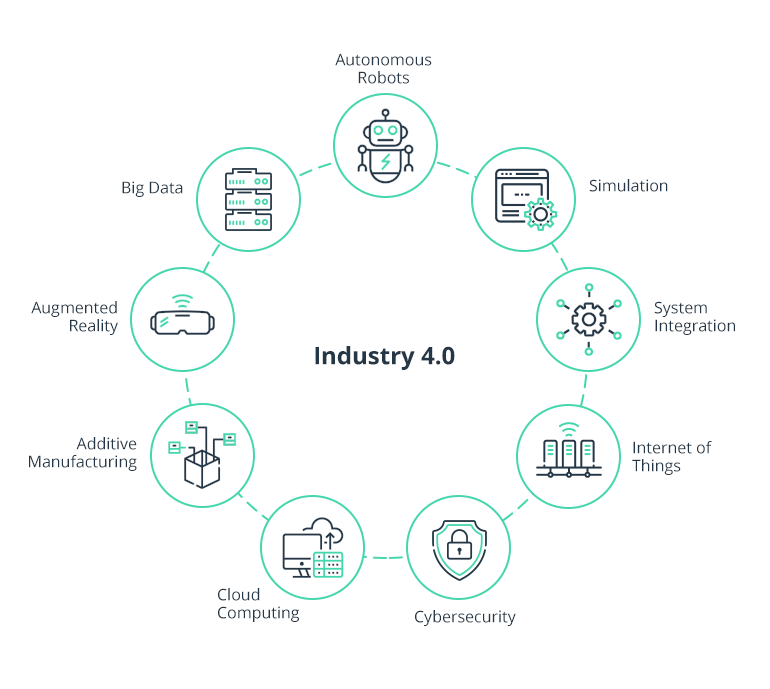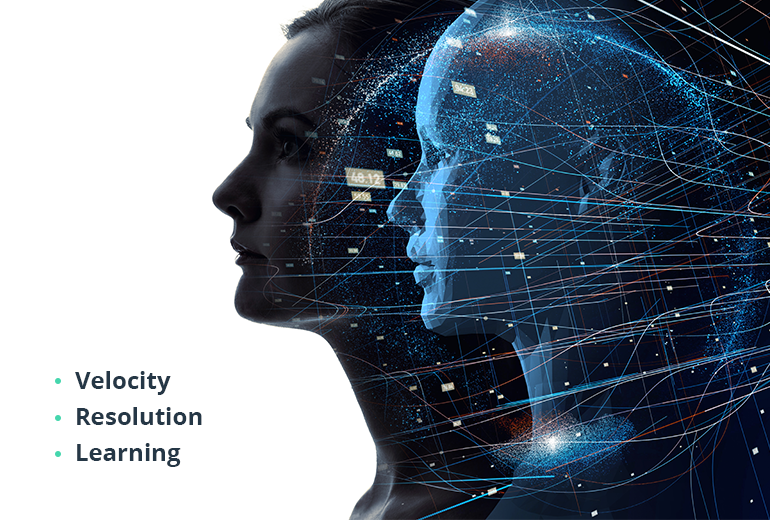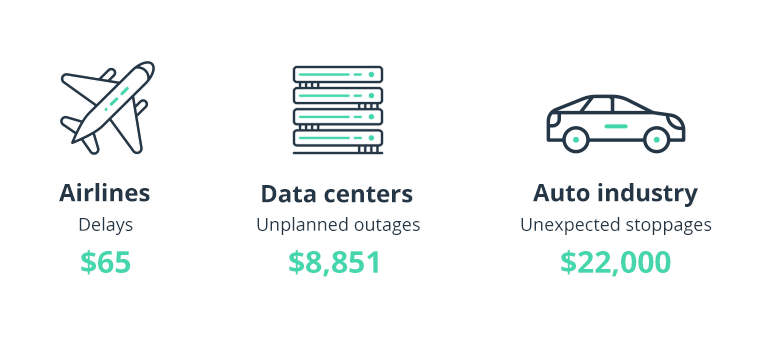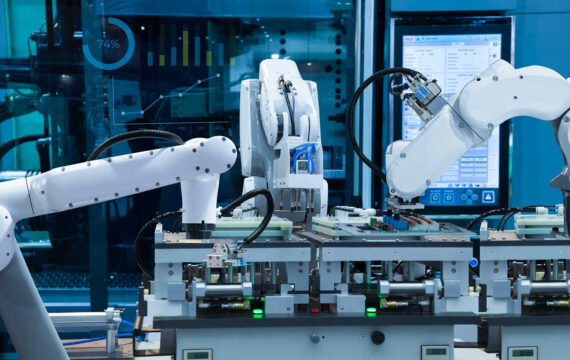A digital twin may sound mysterious and futuristic, but it’s just another trick of Industry 4.0. Digital twin platforms gather the trendiest technologies into fascinating and ambitious solutions with enormous potential across industries. From healthcare to manufacturing to retail, the implementation of digital twins is spreading.
Elements of Industry 4.0

Source: INON Africa – IOA Position Papers
What is a digital twin?
Put simply, a digital twin copies a physical product, process, or service through various IoT devices, pairing the virtual and real worlds. The idea of twins is nothing new. The concept was used as far back as NASA’s pairing technology in the Apollo 13 project. But digital twin technology will only be able to show its full potential after IoT devices become widespread and affordable.
Digital twins, however, shouldn’t be confused with digitization. An IoT digital twin does not substitute a physical item or process with a digital one to make it more accessible, efficient, or secure. It’s a precise replica of the physical object and a means of testing and monitoring it without needing to access to or testing on the real thing.

A lot of businesses could benefit from this:
50 percent of large manufacturers will have at least one digital twin initiative launched by 2020, and the number of organizations using digital twins will triple by 2022.
The three key factors that have made digital twin technology possible are:
- Velocity. IoT devices can relatively easily collect massive volumes of data and transfer it to a digital twin in almost real time.
- Resolution. Digital information helps us get a close look at the finest details of physical assets.
- Learning. Machine learning algorithms can analyze gathered data and make predictions, refining the digital twin based on gathered information and calibrating the general model and its details.
Data gathered through sensors allows a virtual model to act like the real object, meaning that you can manipulate it, monitor various parts and pieces, test new approaches, predict breakdowns, and more. Instead of making assumptions based on general expectations, companies can now apply a digital twin in facility management and actually see, feel the process, and influence it.
For every physical asset in the world, we have a virtual copy running in the cloud that gets richer with every second of operational data.
Moreover, today’s digital twins are growing in complexity: they represent not just single items but systems of interconnected parts. In this way, the possibilities for businesses are not limited to maintenance and testing. Entire processes and organizations can be managed smartly.
Digital twins are extremely valuable for businesses
On top of providing insights into manufacturing processes and how elements function, digital twins can improve and automate decision-making. It can be immensely difficult to decide on recalibrating or replacing equipment when you only have theoretical information to back up your decision. A digital twin gives businesses the weighty arguments they need to make changes and new arrangements. Let’s look at the pros of digital twins in more detail.
- Digital twin technology can connect disparate data sources: business applications and supply chain operations, warehouse data, manufacturing plants, etc. This gives businesses improved productivity, greater operational efficiency, and supply chain and delivery optimizations — not to mention valuable data that can be used in many ways.
- Digital twins give a peek into operations, machines, and separate parts; the scale can vary from a small item inside a fan turbine to the functioning of an entire airport. Businesses can leverage these insights in many ways, predicting maintenance issues, avoiding downtime, or improving customer service, crowd management, and security.
What 1 minute of downtime costs:

Source: Business Insider
- Predictive analysis based on measurement data and enhanced by machine learning is an invaluable asset for modern big businesses. It lets them interact with a digital model of, say, a windmill, ask what-if questions, simulate different situations, experiment with the results, and only then alter the real windmill.
- Digital twin technology can help explain behaviors of machines and robots in factory or medical personnel and patients in a healthcare facility. The result is improved effectiveness of equipment, customized services, and a better customer experience.
What about the cons of digital twins?
The one and the biggest issue that stops companies from integrating digital twin integration is the complexity of doing so.
There’s a naïveté about the possibility of bringing together digital twin concepts in terms of cost and time. It will take longer and will be more resource-consuming than anyone can imagine getting these solutions in place.
To start, digital twin technology requires smarter physical objects. Objects should be equipped with various communicative features such as sensors, antennas, software, and electronics. The abundance and availability of IoT devices make digital twins more of a reality than a dream, but we still need better-thought-out platforms and processes.
Today, creating a digital twin is challenging, since the tools and procedures aren’t mature enough (yet) and experts are few. A digital twin requires the combined work of an operations team, hardware and software engineers, and developers. Few companies can boast integral digital twin platforms.
Who are the digital twin vendors?
There’s no clear understanding of the technology required for large-scale deployment of digital twins, their integration with other systems, and the management of hundreds of different types of twins. Ian Skerrett attempted to define the major features that digital twin platforms should possess. According to Skerrett, a digital twin should:
- be able to manage the digital twin lifecycle
- be able to be updated to reflect the exact state of each separate digital twin
- have an open API that allows any system and IoT device to interact with a digital twin
- provide a means for visualization and analysis
- include process management features for scheduling checks, maintenance status updates, etc.
- manage access and information sharing, enable cooperation within the system, and provide information on ownership, management, responsibility, etc.
General Electric, IBM, Siemens, and Microsoft are among the top players in the digital twin market. From GE Digital (with its Predix products) to Microsoft (with its Azure Digital Twins), tech companies are offering commercial digital twin solutions for different levels of production:
- Components
- Assests
- Systems and units
- Processes
But digital twins also concern other fields, extending far beyond manufacturing.
Use cases of digital twin technology across industries

Obviously, OEM giants are the core clientele of digital twin solutions. Airlines attach barcodes to every significant part, track them in a complete airplane, and analyze their performance through virtual models. Real vehicle systems, from brakes to car interiors, are created on designers’ and engineers’ laptops. Your brand-new car likely has a digital twin somewhere.
But examples of digital twins aren’t limited to production. In retail, digital twins track and trace products along the supply chain, sharing information with stakeholders, organizations, and countries. From the discounts applied along the chain to package updates, information is gathered, stored, and analyzed for a more efficient consumer retail experience.
Healthcare leverages digital twin technology to improve strategic planning and hospital management (to improve the efficiency of building designs, avoid bottlenecks, create operating room schedules and bed plans, etc.); predict maintenance issues with imaging equipment avoid critical system failures of MRI, CT, X-ray, and other systems; and even to model internal organs. Why not? A human being can make a perfect model for a digital twin.
And you won’t be surprised to find out that NASA, the pioneer of what we now consider digital twin technology, is using advanced digital twin technonlogy at the Langley Research Center.
Final thoughts
Businesses see possibilities behind digital twin technology, since it’s a combination of the most efficient and innovative tech trends the last years, showcasing the future of IoT, big data, artificial intelligence, and machine learning solutions.
Innovative products and services are the keys to a company competing on the value of their products and not on the product’s price. Innovative products do differentiate products from those of a company’s competitors.
The task of building an all-encompassing digital twin is not for the fainthearted. It requires expertise in IoT, cloud computing, machine learning, and mobility; but the payoff is worth it. With a reliable partner by your side, you can succeed. Check out Intellias experience with related technologies and ask our experts how they can help you optimize your business.



